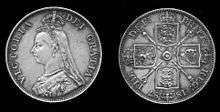Golden Jubilee of Queen Victoria
.jpg)

The Golden Jubilee of Queen Victoria was celebrated on 20 June 1887 on the occasion of the fiftieth anniversary of her accession on 20 June 1837. It was celebrated with a banquet to which 50 European kings and princes were invited.[1]
History

On 20 June 1887 the Queen had breakfast outdoors under the trees at Frogmore, where Prince Albert had been buried. She then travelled by train from Windsor Castle to Paddington then to Buckingham Palace for a royal banquet that evening. Fifty foreign kings and princes, along with the governing heads of Britain's overseas colonies and dominions, attended. She wrote in her diary:[2]
- Had a large family dinner. All the Royalties assembled in the Bow Room, and we dined in the Supper-room, which looked splendid with the buffet covered with the gold plate. The table was a large horseshoe one, with many lights on it.
- The King of Denmark took me in, and Willy of Greece sat on my other side. The Princes were all in uniform, and the Princesses were all beautifully dressed. Afterwards we went into the Ballroom, where my band played.
The following day, she participated in a procession in an open landau through London to Westminster Abbey escorted by Colonial Indian cavalry.
On her return to the Palace, she went to her balcony and was cheered by the crowd. In the ballroom she distributed brooches made for the Jubilee to her family. In the evening, she put on a gown embroidered with silver roses, thistles and shamrocks and attended a banquet. Afterwards she received a procession of diplomats and Indian princes. She was then wheeled in her chair to sit and watch fireworks in the palace garden.[2]
At the Jubilee she engaged two Indian Muslims as waiters, one of whom was Abdul Karim. He was soon promoted to Munshi and taught her Urdu, and acted as a clerk.[3] Her family and retainers were appalled, and accused Abdul Karim of spying for the Muslim Patriotic League, and biasing the Queen against the Hindus.[4] Equerry Frederick Ponsonby (the son of Sir Henry) discovered that the Munshi had lied about his background, and reported to Lord Elgin, Viceroy of India, "the Munshi occupies very much the same position as John Brown used to do."[5] Victoria dismissed their complaints as racial prejudice.[6] Abdul Karim remained in her service until he returned to India with a pension on her death.[7]
A commemorative bust of Victoria was commissioned from the sculptor Francis John Williamson.[8][9][10] Many copies were made, and distributed throughout the British Empire.[8][10]
In 1887 the famous 'pie village' of Denby Dale, home to the Denby Dale Pie Company, created a pie to commemorate the event. It would then spoil, with a second baked a week later, becoming known as the Resurrection Pie.
Black Elk, Queen Kapiʻolani and Crown Princess Liliʻuokalani took part in her Golden Jubilee.
As part of the Jubilee year the First Colonial Conference was held in London.
A special Golden Jubilee Medal was instituted and awarded to participants of the jubilee celebrations.[11]
In Malta the town of Rabat, or Rabato, in Gozo was promoted to a city named "Victoria" on 10 June on the occasion of the Jubilee.
References
- ↑ "Victoria Marked Golden Jubilee With Fireworks". Oxford Review. June 1, 2002. Retrieved 2011-01-24.
After 50 years as ruler of the British Empire, Queen Victoria celebrated her Golden Jubilee by inviting 50 foreign kings and ...
- 1 2 "History of Jubilees: Queen Victoria". British Royal Household. Retrieved 2011-01-24.
The longest-reigning British monarch, Queen Victoria celebrated Golden and Diamond Jubilees marking 50 and 60 years of her reign. Queen Victoria's Golden Jubilee was celebrated on 20 and 21 June 1887. On 20 June the day began quietly with breakfast under the trees at Frogmore, the resting place of her beloved late husband, Prince Albert. ...
- ↑ Hibbert, pp. 447–448; St Aubyn, p. 502; Waller, p. 441
- ↑ Hibbert, pp. 448–449
- ↑ Hibbert, pp. 449–451
- ↑ Hibbert, p. 447; St Aubyn, p. 503; Waller, p. 442
- ↑ Hibbert, p. 454
- 1 2 "Francis John Williamson". 2013. Retrieved 29 August 2013.
- ↑ "F.J. [Francis John] Williamson". The Elmbridge Hundred. Retrieved 3 September 2013.
- 1 2 "Francis John Williamson (1833-1920)". The Victorian Web. Retrieved 3 September 2013.
- ↑ Howard N Cole. Coronation and Royal Commemorative Medals. pp. 5 to 8. Published J. B. Hayward & Son, London. 1977.
Bibliography
- Hibbert, Christopher (2000) Queen Victoria: A Personal History, London: HarperCollins, ISBN 0-00-638843-4
- St Aubyn, Giles (1991) Queen Victoria: A Portrait, London: Sinclair-Stevenson, ISBN 1-85619-086-2
- Waller, Maureen (2006) Sovereign Ladies: The Six Reigning Queens of England, London: John Murray, ISBN 0-7195-6628-2